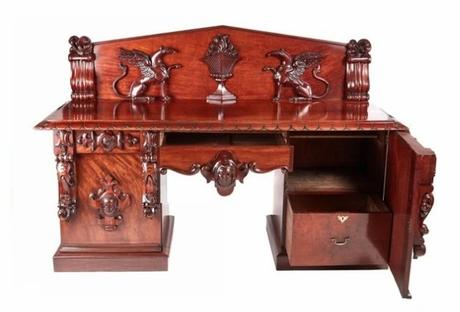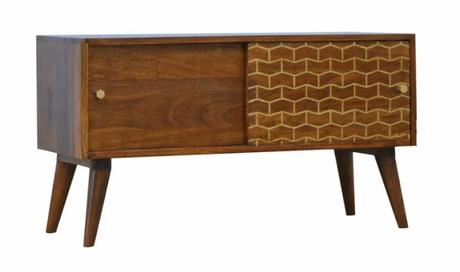When the word first appeared in the Middle Ages, as an alternative to side table, it described a structure used for the display of conspicuously valuable eating utensils. It preserved a basic table shape until the 18th century. The first innovation was the substitution of hollow storage pedestals. Drawers (for napkins, cutlery, and the like) were added in the space beneath the main surface.
Incidentally, when I was reading some background on this I found that side tables are often called credenzas, a word I’ve never come across before. The origin of the word itself comes from the Italian word for belief or the English word credence. This is due to the credenza being the surface on which food was placed when taste-tested by servants for poison, before serving to royalty, noblemen and other people of importance. I’ve been to cafes where this may still be a good idea.

Actual sideboards were introduced during the 1770s in the UK and were made popular by furniture designer Robert Adam. Reference to a sideboard is made in George Hepplewhite’s Cabinet Maker and Upholsterer’s Guide in 1788.
I had to look up the word Upholsterer and it seems they used to be called Upholders and were members of the Worshipful Company of Upholders. I would like to be a member.
With the huge growth in the middle classes in the early 1800s due to the industrial revolution people were able to afford a separate room for dining. The sideboard became a must-have piece of furniture, on which were displayed cut glass lustres, silver candlesticks or polished brass oil lamps plus decanters, perhaps a silver salver, decorative soup tureen or punch bowl. Elaborate fantasies of design often converted the sideboard into a replica of a medieval cathedral or something equally improbable.

By the early to mid 20th Century tastes had changed and the philosophy was that the dining room was a place to eat and not be a museum for china and glass. Simplicity was the order of the day. In my opinion some of the Art Deco pieces produced around the 1920s and 30s were works of art.
My first memories of a sideboard are based around the early 60s. Every house would have one where papers, mementoes, photos etc were stored rather than being used for cutlery and stuff. All that had been moved to the kitchen, especially after room had to be made for the television. Ours was a long slim piece with sliding glass doors that I managed to break.
Thinking about it now I don’t think I know anyone with a sideboard. All my plates cups etc are in the kitchen, my papers are in a filing cabinet or on the computer, my memorabilia are stored in built in cupboards. I don’t think I’d have space for a sideboard.
But apparently there is a good trade in sideboards now but not for the heavy Victorian type more the sleek Art Deco or IKEA type design.
This is the only poem of mine that contains the word sideboard:
CuriousI like to think
that walking these lines
of pencil and paper
will take me to unexpected places
a hidden track
Stonehenge by moonlight
the finding of a tump
and it does
and I’m happy
though you may get to thinking
that it’s not quite enough
and you’d be right
especially if you’d been in Shrewsbury
the day before yesterday
and a slightly open door
to that medieval house
and the tension as I realised
without a shadow of doubt
that she was going in
and I was going to have to follow
not for the first time
and not for the first time
her daft excuse worked
as we left with the owner’s smile
and the history of a vase
on the sideboard in the hall
which we talked about
over flasks of tea
on an oak bench by the river
where she stumped me
by adding a question
regarding our future
which I haven’t thought about
and is hard to imagine.
Terry Quinn.
Email ThisBlogThis!Share to TwitterShare to Facebook